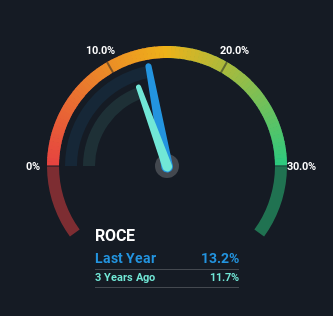Stock Analysis
There's Been No Shortage Of Growth Recently For SOL's (BIT:SOL) Returns On Capital

Did you know there are some financial metrics that can provide clues of a potential multi-bagger? Firstly, we'd want to identify a growing return on capital employed (ROCE) and then alongside that, an ever-increasing base of capital employed. Basically this means that a company has profitable initiatives that it can continue to reinvest in, which is a trait of a compounding machine. So when we looked at SOL (BIT:SOL) and its trend of ROCE, we really liked what we saw.
Return On Capital Employed (ROCE): What Is It?
For those that aren't sure what ROCE is, it measures the amount of pre-tax profits a company can generate from the capital employed in its business. The formula for this calculation on SOL is:
Return on Capital Employed = Earnings Before Interest and Tax (EBIT) ÷ (Total Assets - Current Liabilities)
0.13 = €207m ÷ (€1.9b - €379m) (Based on the trailing twelve months to December 2023).
So, SOL has an ROCE of 13%. In absolute terms, that's a satisfactory return, but compared to the Chemicals industry average of 10% it's much better.
View our latest analysis for SOL

In the above chart we have measured SOL's prior ROCE against its prior performance, but the future is arguably more important. If you'd like, you can check out the forecasts from the analysts covering SOL for free.
What Can We Tell From SOL's ROCE Trend?
The trends we've noticed at SOL are quite reassuring. The data shows that returns on capital have increased substantially over the last five years to 13%. The company is effectively making more money per dollar of capital used, and it's worth noting that the amount of capital has increased too, by 74%. So we're very much inspired by what we're seeing at SOL thanks to its ability to profitably reinvest capital.
The Bottom Line On SOL's ROCE
In summary, it's great to see that SOL can compound returns by consistently reinvesting capital at increasing rates of return, because these are some of the key ingredients of those highly sought after multi-baggers. And with the stock having performed exceptionally well over the last five years, these patterns are being accounted for by investors. With that being said, we still think the promising fundamentals mean the company deserves some further due diligence.
Before jumping to any conclusions though, we need to know what value we're getting for the current share price. That's where you can check out our FREE intrinsic value estimation for SOL that compares the share price and estimated value.
While SOL isn't earning the highest return, check out this free list of companies that are earning high returns on equity with solid balance sheets.
Valuation is complex, but we're helping make it simple.
Find out whether SOL is potentially over or undervalued by checking out our comprehensive analysis, which includes fair value estimates, risks and warnings, dividends, insider transactions and financial health.
View the Free AnalysisHave feedback on this article? Concerned about the content? Get in touch with us directly. Alternatively, email editorial-team (at) simplywallst.com.
This article by Simply Wall St is general in nature. We provide commentary based on historical data and analyst forecasts only using an unbiased methodology and our articles are not intended to be financial advice. It does not constitute a recommendation to buy or sell any stock, and does not take account of your objectives, or your financial situation. We aim to bring you long-term focused analysis driven by fundamental data. Note that our analysis may not factor in the latest price-sensitive company announcements or qualitative material. Simply Wall St has no position in any stocks mentioned.
About BIT:SOL
SOL
Engages in the applied research, production, and marketing of technical and medical gases in Italy and internationally.
Flawless balance sheet with proven track record and pays a dividend.

